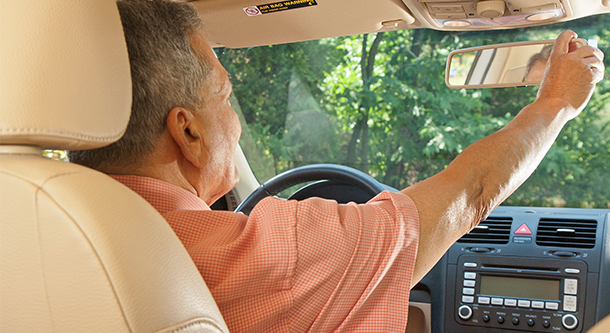
WASHINGTON, D.C. (Nov. 29, 2017) – Nearly 90 percent of older drivers do not make inexpensive adaptations to their vehicles that can improve safety and extend their time behind the wheel, according to new research from the AAA Foundation for Traffic Safety. Common vehicle adaptations like pedal extensions, seat cushions and steering wheel covers can help to improve safety by reducing a senior driver’s crash risk. Seniors aged 65 and over are more than twice as likely as younger drivers to be killed when involved in a crash. AAA urges seniors to consider making the necessary adaptations to their vehicles in order to reduce crash risk and extend the time they can continue to drive.
“While many seniors are considered to be safe drivers, they are also the most vulnerable,” said Dr. David Yang, executive director of the AAA Foundation for Traffic Safety. “Our research suggests that most senior drivers are not taking advantage of simple and inexpensive features like steering wheel covers that can greatly improve their safety and the safety of others on the road.”
The research brief, In-Vehicle Technologies, Vehicle Adaptations, and Older Drivers: Use, Learning, and Perceptions is the first phase in the AAA Foundation for Traffic Safety’s groundbreaking Longitudinal Research on Aging Drivers (LongROAD) project. Researchers are currently engaged in generating the largest and most comprehensive senior driver database in existence. This critical information will support in-depth research to better understand the risks and transportation needs of our aging population.
For this phase of the study, researchers investigated 12 vehicle adaptations and found that fewer than nine percent of senior drivers reported using any of the devices in their vehicles. Some of the inexpensive devices that can be purchased and put to use in new or existing vehicles are:
| Vehicle Device | Potential Safety Impact |
| Cushions and seat pads | Improves line of sight and can help alleviate back or hip pain |
| Convex/ multifaceted mirrors | Improves visibility and minimizes blind spots |
| Pedal extension | Helps drivers obtain a safe distance from the steering wheel/airbag and optimize visibility |
| Steering wheel covers | Improves grip for drivers with arthritic hand joints |
| Hand controls | Allows the driver to perform all vehicle maneuvers and functions without the use of lower extremities |
Choosing the right features and working with a trained technician is imperative to safety behind the wheel. Of those drivers who have a device, almost 90 percent reported that they did not work with a trained professional to install the modification, a key recommendation by both the National Highway Traffic Safety Administration (NHTSA) and the American Occupational Therapy Association (AOTA). AAA urges drivers to consult with a trained technician to guide them in making adjustments to their vehicle.
“When an ache or pain begins hindering driving ability, many older drivers are able to continue driving safely after making a few adjustments,” says Elin Schold Davis, project coordinator of the American Occupational Therapy Association’s Older Driver Initiative. “Occupational therapy practitioners trained in driving rehabilitation are especially valuable in connecting the dots between medical challenges that can affect driving and the appropriate equipment and adaptations needed to remain safely independent in the vehicle.”
Vehicle adaptions also benefit seniors’ mental health by extending their time on the road. Previous research from the AAA Foundation for Traffic Safety shows that seniors who have stopped driving are almost two times more likely to suffer from depression and nearly five times more likely to enter a long-term care facility than those who remain behind the wheel.
In the LongROAD study, more than 70 percent of senior drivers had experienced health conditions that impact muscles and bones such as arthritis, hip/knee replacement and joint pains. Some seniors in the study reduced their driving due to these conditions. The installation of certain devices like steering wheel covers can help lessen the impact of arthritis while larger mirrors and assistive devices on seats can help with limited neck mobility.
“It’s surprising that more seniors are not utilizing simple and inexpensive vehicle adaptations when you consider the large number who are dealing with muscle and joint conditions,” said Jake Nelson, AAA director of traffic safety and advocacy. “Knowledge is power when it comes to extending time behind the wheel, and AAA is committed to providing seniors with the information they need to make sound decisions.”
AAA is promoting the report in partnership with the American Occupational Therapy Association (AOTA) to support Older Driver Safety Awareness Week. AAA and AOTA worked in collaboration with the American Society on Aging and AARP to develop CarFit to help senior drivers better utilize the features and technologies in their vehicles. The community-based program allows trained professionals to conduct a quick, yet comprehensive 12-point check of a senior’s personal vehicle and make recommendations for needed adjustments or adaptations. Older drivers can sign up for an event online. AAA also offers the Smart Features for Older Drivers tool, which can help senior drivers identify in-expensive devices and vehicle features that optimize their comfort and safety.
About LongROAD: Recognizing that lifestyle changes, along with innovative technologies and medical advancements will have a significant impact on the driving experiences of the baby boomer generation, the AAA Foundation for Traffic Safety has launched a ground-breaking, multi-year research program to more fully understand the driving patterns and trends of older drivers in the United States. The LongROAD (Longitudinal Research on Aging Drivers) study is the largest and most comprehensive senior driver database on senior drivers incorporating 2,990 participants. It will support in-depth studies of senior driving and mobility to better understand risks and develop effective countermeasures.
About AAA Foundation for Traffic Safety: Established in 1947 by AAA, the AAA Foundation for Traffic Safety is a not-for-profit, publicly funded, 501(c)(3) charitable research and educational organization. The AAA Foundation’s mission is to prevent traffic deaths and injuries by conducting research into their causes and by educating the public about strategies to prevent crashes and reduce injuries when they do occur. This research is used to develop educational materials for drivers, pedestrians, bicyclists and other road users. Visit www.AAAFoundation.org.
About AAA: As North America’s largest motoring and leisure travel organization, AAA provides more than 57 million members with travel, insurance, financial and automotive-related services. Since its founding in 1902, the not-for-profit, fully tax-paying AAA has been a leader and advocate for the safety and security of all travelers. Motorists can map a route, identify gas prices, find discounts, book a hotel and access AAA roadside assistance with the AAA Mobile app for iPhone, iPad and Android. Learn more at AAA.com/mobile. Find more information on AAA clubs at AAA.com.
